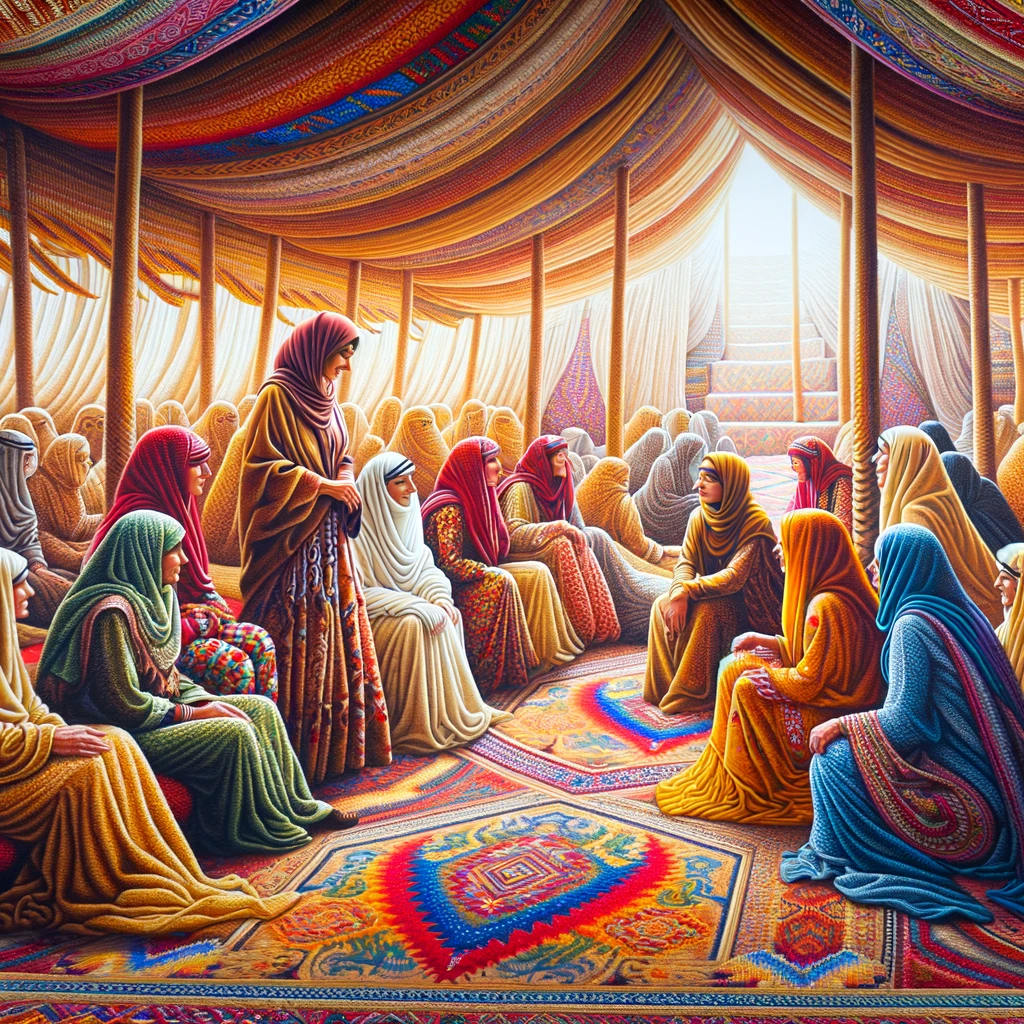Lady Anne Blunt, a prominent writer, and traveler, documented her journey to Nejd in her book “Pilgrimage to Nejd.” In this captivating travel memoir, Lady Anne Blunt shares her firsthand experiences and observations during her exploration of the city of Hail and her interactions with the locals, particularly her encounters with the Emir and his harem. Through her detailed accounts, Lady Anne Blunt’s books offer valuable insights into the culture, society, and leadership of the region during her time.
Exploring the City of Hail
Following her arrival in Nejd, Lady Anne Blunt and her travel companions settled in Hail, an unfamiliar city laden with an air of mystery and defined by its stark contrast from Western societies. The group developing a structured routine which offered some semblance of normality within the foreign city. Blunt’s husband, Wilfrid, and their faithful guide, Mohammed, would frequently visit the mejlis, a gathering place for community decision-making, where they intermingled with locals and partook in discussions. They were often accompanied by a soldier escort to ensure their safety amidst the city’s often unpredictable environment.
Each morning commenced with a breakfast brought by a local slave – a custom jarringly alien to Lady Anne Blunt’s upbringing. As she notes in “Pilgrimage to Nejd“, the food was relatively simple and regional in nature, only further reflecting the stark cultural divergences she was experiencing firsthand.
Lady Anne Blunt, conscious of her position as a female traveler in a highly traditional society, exhibited notable prudence during the expedition. She chose to stay mostly indoors unless accompanying by her husband and guide. The decision, while restrictive, ensured her safety and allowed her to observe daily life and customs from her dwelling in Hail without causing controversy or attracting unnecessary attention.
I stayed very much in doors, and avoided passing through the streets, except when invited to come to the castle, for we had agreed that discretion was the better part of valour. That there was some reason for this prudence I think probable, for though we never experienced anything but politeness from the Hail people, we heard afterwards that some among them were not best pleased at the reception given us by the Emir. Europeans had never before been seen in Nejd; and it is possible that a fanatical feeling might have arisen if we had done anything to excite it. Wahhabism is on the decline, but not yet extinct at Hail; and the Wahhabis would of course have been our enemies.
Pilgrimage To Nejd: Lady Anne Blunt
In her writings, Lady Anne emphasized the importance of caution when navigating strange lands. During her sojourn in Hail, she carefully observed the societal norms and subtly adapted to the conventions of the society she was currently immersed in. This careful manoeuvring around the multifaceted dynamics of Nejdi society offered her a relatively unscathed and enriching experience in the Arabian city of Hail.
Interactions with the Locals
As part of her exploration of Hail, Lady Anne Blunt found herself interacting frequently with the local residents. Her accounts provide keen insight into the character and cultural nuances of the local community. An essential part of this diverse group of individuals was Hamiid, Mubarek, and the Emir himself, all of whom played significant roles during her stay in Hail.
Lady Anne Blunt formed a particularly warm rapport with Hamiid and his family. Despite Hamiid’s self-evident distaste for some aspects of the Emir’s governance, he remained loyal to his rule, showing a sense of duty that impressed the Western travellers. Lady Anne Blunt narrates their conversations, highlighting the local customs, traditions, and societal norms that came to light.
Adding another dynamic to the narrative was Hamiid’s son, Majid. Lady Anne Blunt describes Majid as a charming boy, full of life and energy. Her interactions with Majid offered a glimpse into the everyday lives and aspirations of the young inhabitants of Hail, highlighting their cultural and societal values.
As for the Emir, he was, according to Lady Anne, a man who craved attention and whose actions seemed driven by a desire for display and dominance. Conversely, Hamiid was a figure of modesty and piety. The contrast between these two key characters offers a fascinating snapshot of the diverse personalities and power dynamics at play in Hail at the time of Lady Anne’s travels.
The Emir is different ; with him there was always a certain gêne. It was impossible to forget the horrible story of his usurpation ; and there was something, too, about him which made it impossible to feel quite at ease in his presence. Though he knows how to behave with dignity, he does not always do so. It is difficult to reconcile his almost childish manner, at times, with the ability he has given proofs of. He has something of the spoiled child in his way of wandering on from one subject to another ; and… asking questions which he does not always wait to hear answered, a piece of ill-manners not altogether unroyal, and so, perhaps, the effect of his condition as a sovereign prince. He is also very naively vain, as most people become who are fed constantly on flattery; and lie is continually on the look-out for compliments about his power, and his wisdom, and his possessions. His jealousy of other great Sheikhs whom we have seen is often childishly displayed.
Pilgrimage To Nejd: Lady Anne Blunt
Lady Anne Blunt’s discourse with the locals was not just a social endeavour but also a critical part of her study of the region. By closely observing and interacting with the people of Hail, she was able to gain an intimate understanding of their culture. By doing so, she provided a detailed, multi-dimensional perspective on a society foreign to most of her readers.
Experiences in the Harem
Lady Anne Blunt’s exploration of Nejd afforded her the rare opportunity to visit the harems of the local ruler. Her intuitive observations of life in these secluded quarters are documented extensively in “Pilgrimage to Nejd,” offering a compelling glimpse into an otherwise cloistered world. Lady Anne was introduced to the Emir’s wives during her routine visits, interactions that were marked with a fair share of patience and restraint, reflecting the integral culture of the haram.
Lady Anne’s accounts reveal that the Emir displayed a particular curiosity about the condition of women from the neighbouring tribes. He posed questions to Lady Anne in an impassive manner, yet his expression suggested a more profound intermingling of curiosity and concern. Such exchanges indicate a renewed understanding of the ruler’s multifaceted personality which went beyond the reputation garnered by his public persona.
Amid her accounts of these courtly visits, Lady Anne brings forth fascinating descriptions of local fashion trends. She vividly recounts the women of the harem sporting elaborate hair plaits, nose rings, and an impressive display of gold, turquoise, and pearl jewellery, reflective of the area’s rich traditions. This illustrates the aesthetic sensibilities of Nejd and adds a layer of sophistication and vibrancy to our perception of life in the harem.

A notable aspect of Lady Anne’s harem visits was her encounter with Hamud’s wives, who, unlike the Emir’s women, practiced more westernized customs in their everyday lives. These practices were markedly less formal, and the act of veiling was not as staunchly adhered to. The wives conversed freely with Lady Anne, often displaying an openness that surprised her. Their readiness to embrace western customs offered a stark contrast to the otherwise traditional societal structure of the region, indicating the early transformations of Nejd society under the influences of global culture.
Through her interactions within the harems, Lady Anne Blunt manages to create a comprehensive, first-person view of harem life that is deeply introspective and authentic. Her accounts from “Pilgrimage to Nejd” paint an intricate tapestry of the region’s history, creating an indelible record of neglected aspects of Central Arabian society during her time.
Ibn Rashid’s Display of Material Possessions
No account of Lady Anne Blunt’s experiences in Nejd would be complete without discussing the Emir and his resplendent display of material possessions. During her visits to the Emir’s palace, Lady Anne was shown his weapons, a keen demonstration of his power and prestige. Observed in her book “Pilgrimage to Nejd”, numerous old-fashioned guns and daggers were among the items proudly placed on show by the Emir.
Lady Anne Blunt describes the weapons as bearing designs that were both intricate and powerful, serving as an embodiment of the martial character of the city’s ruler. Particularly surprising to her was the old-fashioned nature of the collection, with many of the pieces appearing to belong to bygone times. In stark contrast to the city’s limited technological advancement, the Emir’s possession of these objects seemed to represent both the enduring heritage and the power of the region’s leadership.
The display also provided an intriguing insight into the craftsmanship of Hail. As Lady Anne Blunt puts it, the weapons bore the mark of the city’s goldsmiths, a testimony to their skill and craftsmanship. They were a clear indication of the rich cultural heritage of Hail, embedded in the artisanal traditions of its people.
There were eighteen or twenty swords, and several guns and daggers, arranged with some care and taste as ornaments. The guns were all very old-fashioned things, with long barrels, but most of them beautifully inlaid with silver.
Pilgrimage To Nejd: Lady Anne Blunt
In contrast to the extravagance of the Emir’s court was the room in which Lady Anne Blunt’s companion, Beneyeh, stayed. It was relatively modest yet tastefully adorned with a few of the Emir’s own weapons, serving as a status symbol and perhaps a subtle reiteration of the Emir’s power.
Lady Anne Blunt’s impressions of the material possession of the Emir offer an intriguing glimpse into the status symbols of the time, while also reflecting the vast difference in wealth and power that existed within the society of Hail.
Assessment of the Emir’s Leadership
Through her carefully documented observations, Lady Anne Blunt provides a captivating glimpse into the leadership style of the Emir during her stay in Hail. Her narrative in “Pilgrimage to Nejd” offers detailed accounts examining how the Emir navigated the dynamics of Nejdi society, revealing intricate elements of his governance style and political strategies.
The Emir’s leadership, as noted by Lady Anne, was characterized by a distinct and powerful presence that served to constantly remind her and others of his authority. He maintained a careful balance of power, demonstrating both humility, when necessary, and assertiveness when needed. His behaviours suggest a strong consciousness of image, presumably intended to inspire respect and loyalty among his subjects.
Among the defining traits of the Emir’s rule, Lady Anne Blunt identified a clear display of ambition. Through his display of material possessions and his conduct at the majlis, as well as his approach to local governance, the Emir revealed a keen desire for progress and elevation of his status – his actions, according to Lady Anne, underscored a basic human trait of aspiration.
Though fraught with personal jealousies and power struggles, the Emir demonstrated a surprising depth of political insight and intuition. He showcased an understanding of human dynamics, cleverly managing complicated relationships with loyalty and guile. Lady Anne further observed that the Emir seemingly had a grasp of realpolitik which allowed him to maintain a steady rule, infused with a blend of sternness and charm, over his subjects.

His character is, as I have already said, a strange mixture of remarkable ability and political insight on the one hand, and on the other a tendency to waste time and thought on the most foolish trifles, if they touch his personal vanity. Of his ability I judge by his extremely interesting remarks on serious subjects, as well as by the position he has been able to seize and to keep. Of his energy no one can doubt, for he has shown it, alas, by his crimes ; but he is so eaten up with petty personal jealousies, that I sometimes wonder whether these would influence his conduct at an important political crisis.
Pilgrimage To Nejd: Lady Anne Blunt
By analysis, Lady Anne Blunt provides the reader with a rich context of the socio-political setting of Nejd during her visit. By keenly observing varying factors, from the Emir’s personal characteristics to his leadership style, Lady Anne Blunt sheds a unique light on how society and politics operated in Nejd during the 19th century, offering a fascinating probe into a previously underexplored region and period.
Conclusion
Lady Anne Blunt’s exploration of the city of Hail offered a profound insight into the daily lives of its inhabitants, shedding light on the customs, traditions, and power dynamics prevalent in the region. Lady Anne Blunt’s interactions with the diverse array of individuals in Nejd, from the Emir to Hamiid and his son Majid, offered a nuanced understanding of the different personalities and societal norms at play.
Visits to the Emir’s harem and witnessing the opulent display of material possessions further enriched Lady Anne Blunt’s narrative, providing a comprehensive view of the cultural and social fabric of Nejd. Her keen observations and detailed accounts serve as a valuable record of a society in transition, capturing the essence of a period marked by cultural diversity and evolving traditions.

